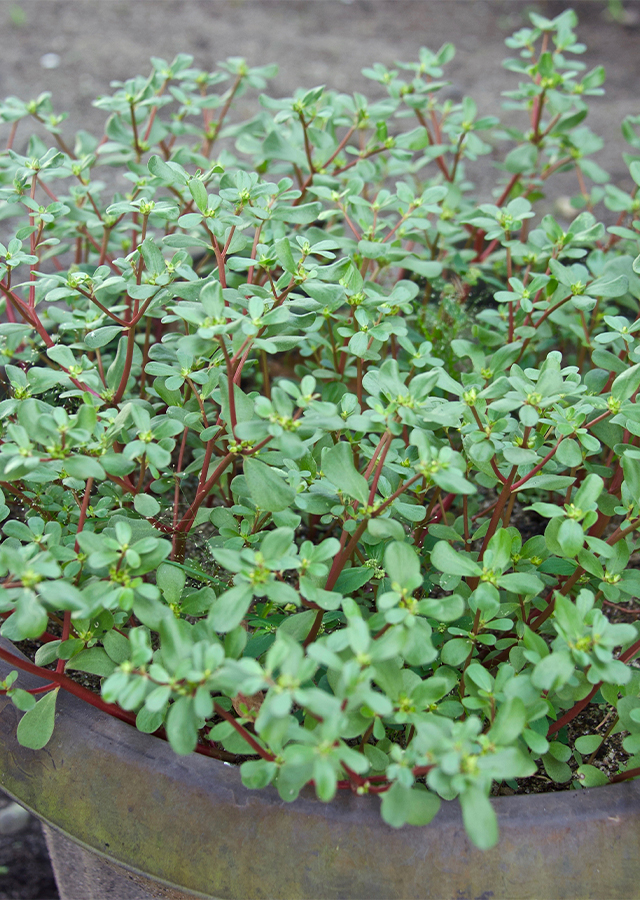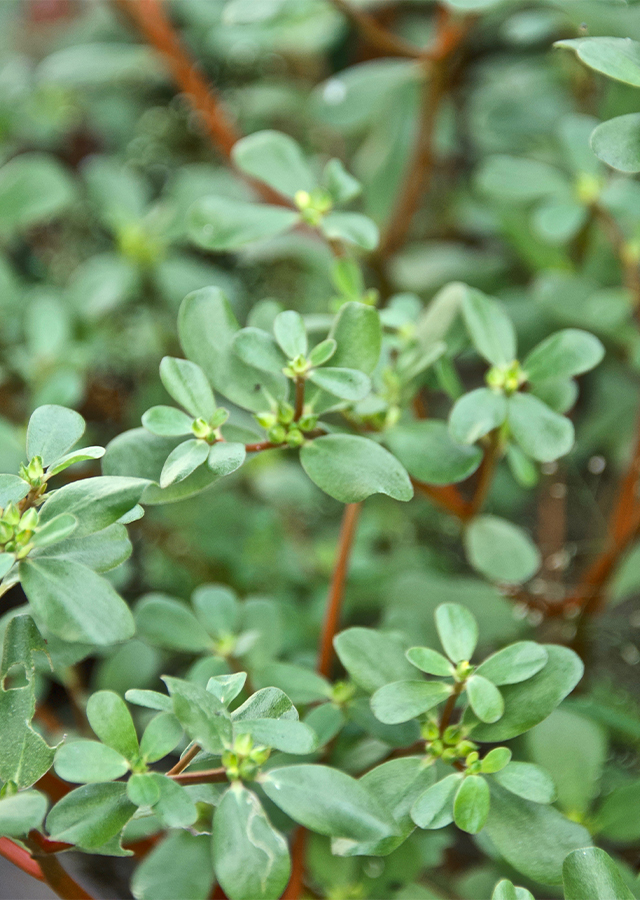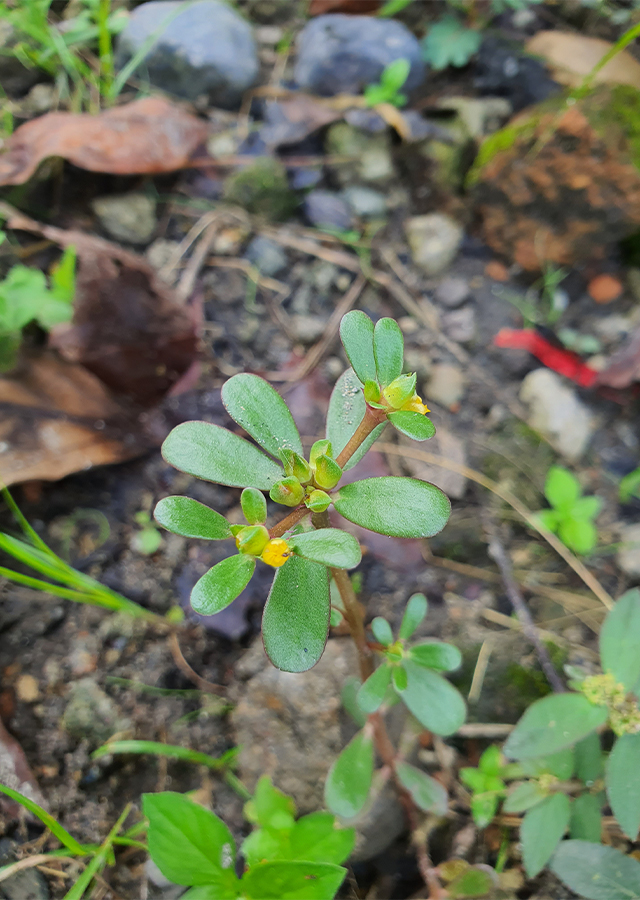Purslane
Portulaca oleracea L.
Portulacaceae
Location in our garden
Principal



Synonym
Portulaca aurea DC.
Portulaca consanguinea Schltdl.
Portulaca cryptopetala var. poellnitziana (D.Legrand) D.Legrand
Habitus
Herbaceous. An erect or ascending, copiously-branched, succulent, annual to perennial plant, 20 to 50 cm tall
Part Used
Leaves
Roots
Stem
The Whole Plant
Growing Requirements
Need Shade
Habitat
Wetland
Riverbanks
Forest
Coastal
Grassland
Overview
Purslane is native to Macaronesia, Tropical Africa, Mediterranean to Pakistan and Arabian Peninsula. It has been used since ancient times in folk medicine and is included in the list of medicinal plants most commonly used by the World Health Organization. This plant is also absolutely edible (raw or cooked). Purslane leaves also consist of a broad variety of health-boosting nutrients, such as omega-3 fatty acids, antioxidant vitamins and minerals, in addition to culinary facets, which are highly important for promoting our health.
Vernacular Names
Ma chi xian (Chinese), Postelein (Dutch), Pourpier (French), Portulak (German), Koorsa (India), Suberi-hiyu (Japanese), Golasiman (Philippines), Phak bia yai (Thai).
Agroecology
P. oleracea can be grown at elevations of up to 1,700 m in the tropics. In areas with annual daytime temperatures between 18-32 °C, it grows best. Average annual rainfall in the range of 1,000-2,000 mm is preferred. It needs well-drained soil rich in moist light in a sunny location. Plants are adaptable, even mildly saline, to most soils. A pH in the 5.5-7 range is favored, tolerating 4.3-8.3.
Morphology
- Roots - fibrous secondary taproot.
- Stems - glabrous, fleshy, purple-red to green, forming mats, arising from a taproot, sometimes prostrate.
- Leaves - fleshy, smooth, oblong-obovate, 1 to 2.5 cm long, with a dark green colored obtuse apex and a wedge-shaped base.
- Flowers - in a group at the end of the stem, yellow, stalkless, axillary and terminal few
- Heads - with compressed buds are solitary, or cymose. The petals are five and yellow, nearly as long as the sepals, and the tip is notched. The flowers are only open for several hours in the morning.
- Fruits - capsules that horizontally dehiscate.
- Seeds - black when mature, but when immature, they may be red or brown, 0.6-1 mm long, usually with flat-stellate granulate surfaces.
Cultivation
Propagated through seeds and stem cuttings.
Chemical Constituents
Headspace gas chromatography-mass spectrometry (GC-MS) analyses revealed six volatile classes from ethanol leaf extract of Purslane with monoterpene hydrocarbons, oxygenated monoterpenes, and non-terpene derivatives as the highly represented compounds. Limonene (17.3–32.2%), carvone (38–46%), 2,6-dimethylcyclohexanol (2.2–6.4%), and nonanal (3.4–3.8%) were the most abundant volatiles. In addition, Purslane contains of alkaloids, steroids/terpenoids, tannins, saponins, flavonoids, and organic acid (oksalat acid, caffein acid, mallat acid, citrat acid).
Traditional Medicinal Uses
- Muscle-relaxing effects have been seen in aqueous extracts from the plant.
- Ethanolic extracts have shown strong analgesic and anti-inflammatory effects.
- When applied topically, a raw extract of the plant has been shown to speed up wound healing.
- An ethanol extract demonstrated antifungal activity against Trichophyton dermatophytes.
- Plant extracts have demonstrated antityrosinase activity and their skin-whitening activity is being studied.
- The plant is antibacterial, depurative, antiscorbutic, diuretic and febrifuge.
- Leaves are critical for preventing and strengthening the immune system from heart attacks.
- Pounded leaves and stems for tumors, swellings, bruises, gout and erysipelas. Leaves are used for poulticing tumors, bad wounds and ulcers, also for blenorrhagia and leucorrhea.
- Decoction of leaves used as a wash for skin diseases.·
- Leaves juice are used for dysmenorrhea, dysuria, dysentery, and for expelling worms.
- Decoction of seeds is used as diuretic.
Part Used
Reference Sources
- CABI. (No date). Invasive Species Compendium. Portulaca oleracea (purslane). https://www.cabi.org/isc/datasheet/43609 15-09-2020.
- Fern, Ken. (2016). Useful Tropical Plants Database. Portulaca oleracea L. http://tropical.theferns.info/viewtropical.php?id=Portulaca+oleracea 15-09-2020.
- Health & Benefit Times.com. (No date). Purslane facts and health benefits. https://www.healthbenefitstimes.com/purslane/ 15-09-2020.
- Stuartxchange. (2016). Philippines Medicinal Plants. Portulaca oleracea (Linn.) http://www.stuartxchange.com/Gulasiman.html 15-09-2020.
- Dabbou, S., Lahbib, K., Pandino, G., Dabbou, S. & Lombardo, S. (2020). Evaluation of Pigments, Phenolic and Volatile Compounds, and Antioxidant Activity of a Spontaneous Population of Portulaca oleracea L. Grown in Tunisia. Agriculture 10(353): 1-14.


